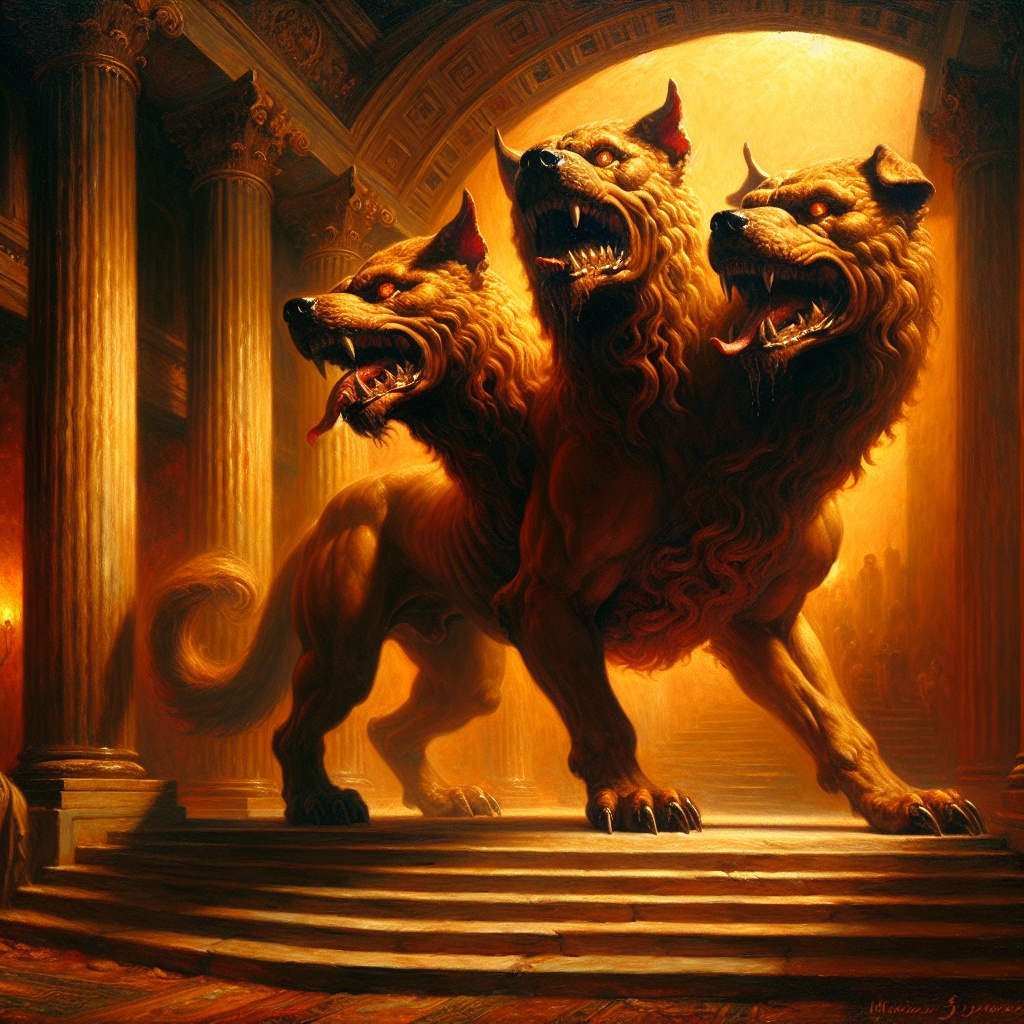Hades, the Greek god of the underworld, is one of the most fascinating and often misunderstood figures in Greek mythology. His role in mythology goes beyond his fearsome reputation as the ruler of the dead, offering deep insights into the ancient Greek view of life, death, and the afterlife. Let’s explore who Hades was, his powers, the symbols associated with him, and the captivating myths that make him such an intriguing figure.
Jump To:
Recommended for you!
Best SellersWho Was Hades?
Hades, also known as the god of the underworld, was the brother of Zeus and Poseidon. Together, they were the three powerful rulers of the cosmos, dividing the realms among themselves after overthrowing their father, Cronus. Zeus took the sky, Poseidon ruled the seas, and Hades was given dominion over the underworld—a realm where souls resided after death.
The name Hades often conjures fear, but he wasn’t inherently evil. In fact, ancient Greeks saw him as a necessary figure, maintaining the balance of life and death. His presence ensured the souls of the deceased had a place to go, and he upheld the laws of the afterlife with fairness and unwavering authority.
What Is Hades Known For?

Hades is primarily known as the ruler of the underworld, but his influence extends further. He was associated with wealth and abundance, as many believed that precious metals and gems came from beneath the earth’s surface—Hades’ domain. For this reason, he was sometimes called “Plouton,” meaning the giver of wealth.
Hades is also known for his role in one of mythology’s most enduring love stories: the abduction of Persephone. This tale not only explains the change of seasons but also offers a glimpse into Hades' complex personality, blending sternness with moments of vulnerability.
Powers and Symbols of Hades
Hades’ powers revolved around control over the underworld and the dead. He could prevent souls from leaving and enforce the natural order of life and death. He also possessed the power to make himself invisible, thanks to a magical helmet called the Helm of Darkness, gifted to him by the Cyclopes.
Symbols associated with Hades include:
- The Helm of Darkness: Representing his ability to remain unseen.
- Cerberus: His three-headed dog, who guarded the gates of the underworld.
- The Cypress Tree: A symbol of mourning and death.
- The Narcissus and Pomegranate: Both linked to his connection with Persephone and the cycles of life and death.
Where Does Hades Live?
Hades resided in the underworld, a vast and shadowy realm located beneath the earth. The underworld was not a place of torment for all souls—only the wicked were punished, while others experienced a neutral or even pleasant afterlife.
The entrance to the underworld was guarded by Cerberus, and its boundaries were marked by the rivers of Hades. These rivers played significant roles in transporting souls and symbolising aspects of death and rebirth.
The Five Rivers of Hades

The underworld was home to five mythical rivers, each with its own symbolic meaning:
- Styx: The river of unbreakable oaths, used by the gods to swear binding promises.
- Lethe: The river of forgetfulness, where souls would drink to forget their earthly lives.
- Acheron: The river of pain, which ferried souls into the underworld.
- Phlegethon: The river of fire, often depicted as a burning torrent.
- Cocytus: The river of wailing, representing lamentation and sorrow.
These rivers emphasise the underworld’s complexity, illustrating its role in the spiritual journey of souls.
Was Hades Good or Evil?
Hades is often misunderstood as purely malevolent, but ancient Greeks didn’t see him as evil. Unlike Zeus, who was known for his temper and impulsiveness, Hades was considered just and disciplined. He rarely left the underworld and didn’t interfere in mortal affairs unless necessary. His stern demeanour reflected his role as the ruler of a realm where fairness and order were paramount.
Myths and Stories Featuring Hades

Hades features prominently in some of the most memorable myths in Greek mythology. These stories reveal his power and role in the cosmic order, highlighting his complex character—stern, fair, and occasionally compassionate.
The Story of Hades and Persephone
The myth of Hades and Persephone is one of the most famous stories in Greek mythology. Hades fell in love with Persephone, the daughter of Demeter, and abducted her to the underworld. Heartbroken, Demeter caused the earth to wither, leading to the first winter. Eventually, a compromise was reached—Persephone would spend part of the year with Hades and the rest with her mother, symbolising the cycle of seasons.
This story raises questions about consent and love, but it also highlights themes of balance and duality. Did Persephone grow to love Hades? Some versions suggest she did, portraying their relationship as a complex mix of power, devotion, and mutual respect.
Heracles and the Capture of Cerberus
One of Hades' notable appearances is in the tale of Heracles' Twelve Labours. As his final task, Heracles was ordered to capture Cerberus, the three-headed dog that guarded the gates of the underworld.
To accomplish this, Heracles had to enter Hades' realm alive, an unprecedented feat. Hades, impressed by Heracles' courage, allowed him to take Cerberus on the condition that he used no weapons and returned the creature unharmed. This story reveals Hades' respect for bravery and adherence to fairness.
Orpheus and Eurydice
Orpheus, a musician of unparalleled talent, descended into the underworld to retrieve his wife, Eurydice, who had died tragically. Orpheus played his lyre so beautifully that it moved Hades and Persephone to grant him a chance to bring Eurydice back to life.
However, there was one condition: Orpheus must not look back at her as they ascended to the surface. Tragically, he turned around at the last moment, and Eurydice was lost forever. This myth highlights Hades’ capacity for compassion, though his conditions were firm and immutable.
Sisyphus’ Eternal Punishment
Sisyphus, a cunning king, attempted to cheat death multiple times, angering Hades. As punishment, Hades condemned him to an eternal task: rolling a boulder up a hill, only for it to roll back down each time he neared the top. This story illustrates Hades’ role as a strict enforcer of justice, ensuring that no one could escape the natural order.
Pirithous and Theseus’ Failed Quest
Pirithous and Theseus, legendary heroes, foolishly decided to kidnap Persephone from the underworld, believing they could outwit Hades. Upon their arrival, Hades feigned hospitality and invited them to sit on magical chairs, which bound them to their seats for eternity. While Theseus was later rescued by Heracles, Pirithous remained trapped. This tale demonstrates Hades’ cunning and his unyielding authority in his domain.
Interesting Facts About Hades
- Hades was often depicted as a sombre figure, with a dark beard and a regal presence.
- Despite his reputation, Hades was considered a faithful husband to Persephone, with few myths suggesting infidelity.
- His sacred animals included serpents and black horses, symbolising his connection to the underworld.
- The narcissus flower, associated with Persephone’s abduction, is another symbol linked to Hades.
Hades in Art and Literature
Hades’ role as the god of the underworld has inspired numerous works of art and literature, highlighting his connection to mortality and the mysteries of the afterlife. In classical texts like Homer’s Odyssey and Hesiod’s Theogony, Hades is depicted as a sombre yet just ruler of the dead.
Visual art often portrays him alongside Persephone, symbolising their shared dominion over the underworld. In modern literature, Rick Riordan’s Percy Jackson series reimagines Hades as a complex and morally ambiguous character, showing his enduring appeal in exploring themes of justice, power, and the unknown.
Recommended for you!
Best SellersFrequently Asked Questions About Hades
Did Hades and Persephone have children?
In some myths, Hades and Persephone are said to have children, though they are not as well-known as other offspring of the Olympian gods. Their children include Melinoë, a goddess associated with ghosts and the afterlife, and Zagreus, a figure linked to rebirth and mystery cults.
Why did the Greeks fear Hades?
The Greeks feared Hades not because he was evil, but because he represented death, a mysterious and inevitable part of life. Uttering his name was often avoided, and euphemisms like "Plouton" (the wealthy one) were used instead, highlighting his connection to underground riches.
Was Hades worshipped in ancient Greece?
Hades was worshipped, but not as prominently as other gods. His worship often took place in chthonic (underworld-related) rituals, which included offerings buried underground or made at night. Temples dedicated specifically to Hades were rare, reflecting the reverence and fear surrounding his domain.
What animals were sacred to Hades?
Hades’ sacred animals include serpents and black horses, symbolising his connection to the underworld and its mysteries. Cerberus, the three-headed dog, is also closely associated with him as the guardian of the underworld’s gates.
What did Hades' palace look like?
Hades’ palace, located deep within the underworld, was described as a dark and gloomy place. It was made of precious metals, reflecting his association with wealth. Despite its grandeur, it exuded an air of foreboding, befitting the ruler of the dead.
Who were Hades’ allies?
Hades’ closest allies included Charon, the ferryman who transported souls across the river Styx, and Cerberus, the guardian of the underworld. He also worked closely with Thanatos, the personification of death, and the Fates, who determined the lifespan of mortals.
What were the Eleusinian Mysteries, and how were they connected to Hades?
The Eleusinian Mysteries were secret religious rites in ancient Greece, centred on the myth of Demeter and Persephone. Hades was a key figure in this myth, as Persephone’s abduction by him and her eventual return to Demeter symbolised death, rebirth, and the agricultural cycle.
Can Hades leave the underworld?
In myths, Hades rarely left the underworld, as he was deeply tied to his responsibilities there. However, there are exceptions, such as when he appeared to grant or enforce decrees involving other gods or mortals.
Discover More About Greek Mythology
Hades’ story is just one of many captivating tales in Greek mythology, full of complex characters and dramatic twists. If you’d like to learn more about these myths and explore the characters, symbols, and stories that have shaped Western culture, consider enrolling in the Greek Mythology Diploma Course with Centre of Excellence. For a limited time, you can access the course at a discounted price of £29!













